CSE4026-N-BF1 Business Research Methods: Reflective Report on Data
VerifiedAdded on 2023/04/21
|11
|3216
|457
Report
AI Summary
This reflective report explores the qualitative and quantitative data approaches, emphasizing the importance of evaluating research findings based on appropriate criteria for each paradigm. It critically evaluates a qualitative research paper on nursing education in the Arab world and a quantitative study on nursing students' experiences with clinical training. The report discusses the concepts and theories underlying both qualitative and quantitative research, including sampling techniques, data collection methods, and data analysis tools like SPSS. It highlights the strengths and limitations of each approach, connecting theory to practice and reflecting on personal philosophical beliefs within the context of business research methods.
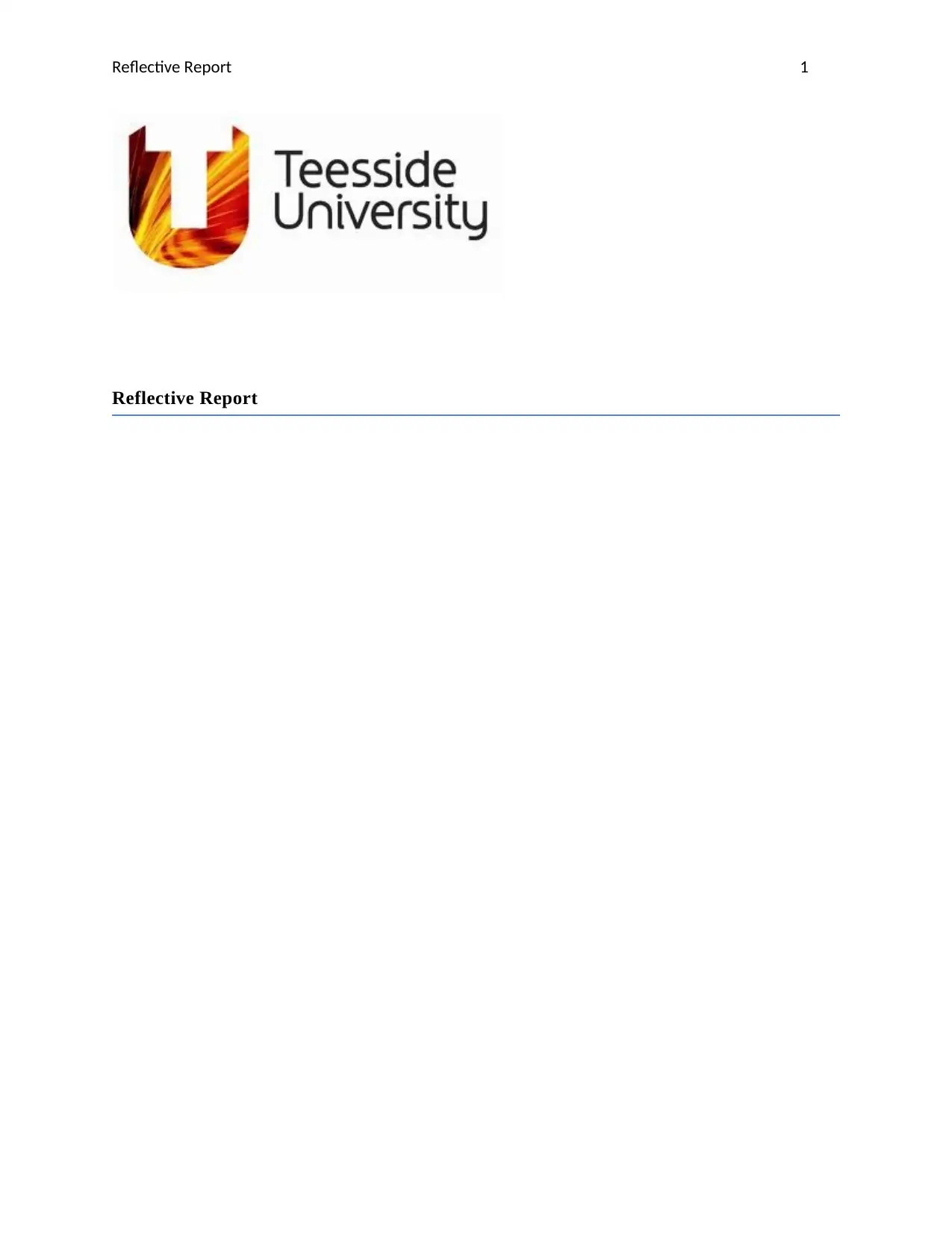
Reflective Report 1
Reflective Report
Reflective Report
Paraphrase This Document
Need a fresh take? Get an instant paraphrase of this document with our AI Paraphraser
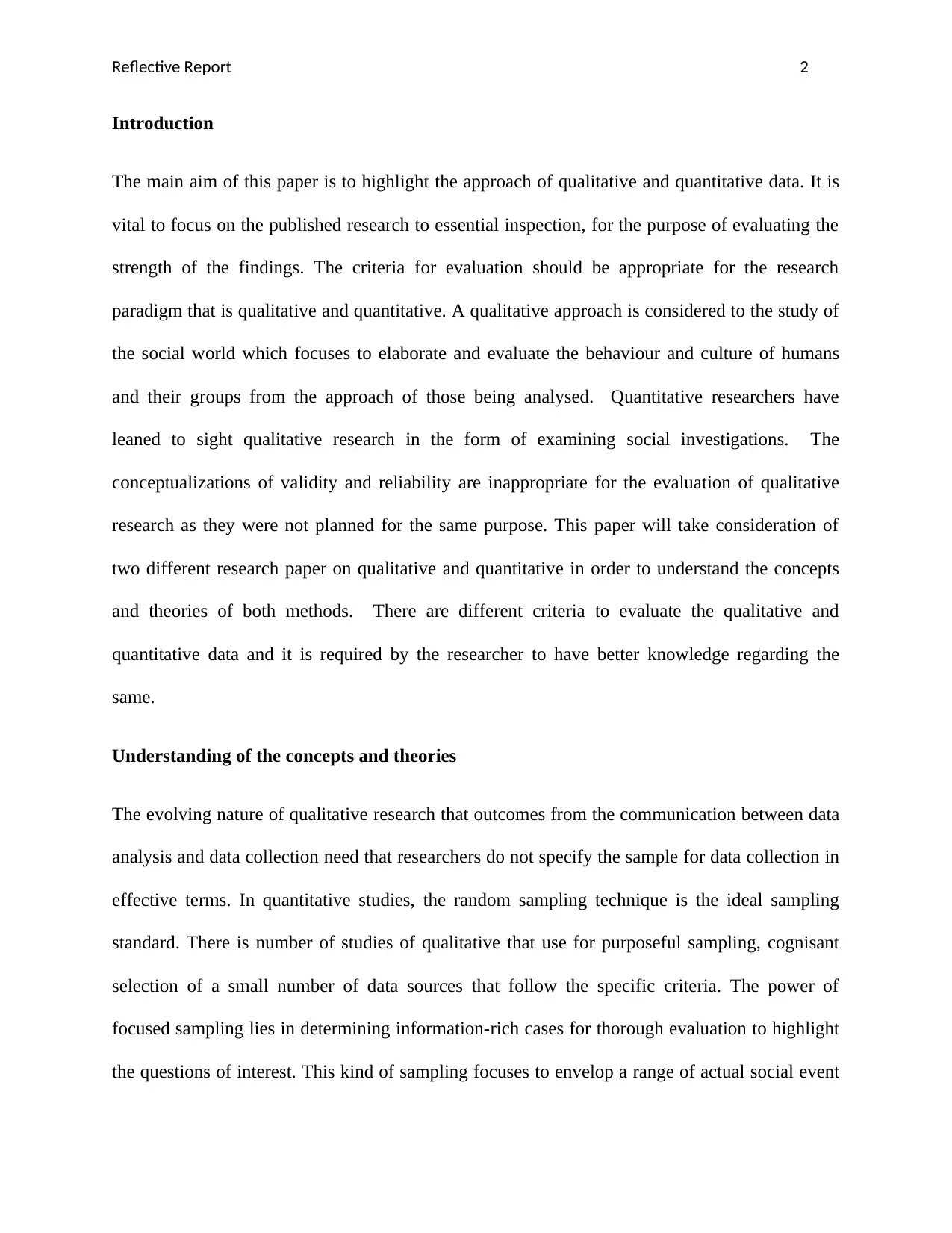
Reflective Report 2
Introduction
The main aim of this paper is to highlight the approach of qualitative and quantitative data. It is
vital to focus on the published research to essential inspection, for the purpose of evaluating the
strength of the findings. The criteria for evaluation should be appropriate for the research
paradigm that is qualitative and quantitative. A qualitative approach is considered to the study of
the social world which focuses to elaborate and evaluate the behaviour and culture of humans
and their groups from the approach of those being analysed. Quantitative researchers have
leaned to sight qualitative research in the form of examining social investigations. The
conceptualizations of validity and reliability are inappropriate for the evaluation of qualitative
research as they were not planned for the same purpose. This paper will take consideration of
two different research paper on qualitative and quantitative in order to understand the concepts
and theories of both methods. There are different criteria to evaluate the qualitative and
quantitative data and it is required by the researcher to have better knowledge regarding the
same.
Understanding of the concepts and theories
The evolving nature of qualitative research that outcomes from the communication between data
analysis and data collection need that researchers do not specify the sample for data collection in
effective terms. In quantitative studies, the random sampling technique is the ideal sampling
standard. There is number of studies of qualitative that use for purposeful sampling, cognisant
selection of a small number of data sources that follow the specific criteria. The power of
focused sampling lies in determining information-rich cases for thorough evaluation to highlight
the questions of interest. This kind of sampling focuses to envelop a range of actual social event
Introduction
The main aim of this paper is to highlight the approach of qualitative and quantitative data. It is
vital to focus on the published research to essential inspection, for the purpose of evaluating the
strength of the findings. The criteria for evaluation should be appropriate for the research
paradigm that is qualitative and quantitative. A qualitative approach is considered to the study of
the social world which focuses to elaborate and evaluate the behaviour and culture of humans
and their groups from the approach of those being analysed. Quantitative researchers have
leaned to sight qualitative research in the form of examining social investigations. The
conceptualizations of validity and reliability are inappropriate for the evaluation of qualitative
research as they were not planned for the same purpose. This paper will take consideration of
two different research paper on qualitative and quantitative in order to understand the concepts
and theories of both methods. There are different criteria to evaluate the qualitative and
quantitative data and it is required by the researcher to have better knowledge regarding the
same.
Understanding of the concepts and theories
The evolving nature of qualitative research that outcomes from the communication between data
analysis and data collection need that researchers do not specify the sample for data collection in
effective terms. In quantitative studies, the random sampling technique is the ideal sampling
standard. There is number of studies of qualitative that use for purposeful sampling, cognisant
selection of a small number of data sources that follow the specific criteria. The power of
focused sampling lies in determining information-rich cases for thorough evaluation to highlight
the questions of interest. This kind of sampling focuses to envelop a range of actual social event
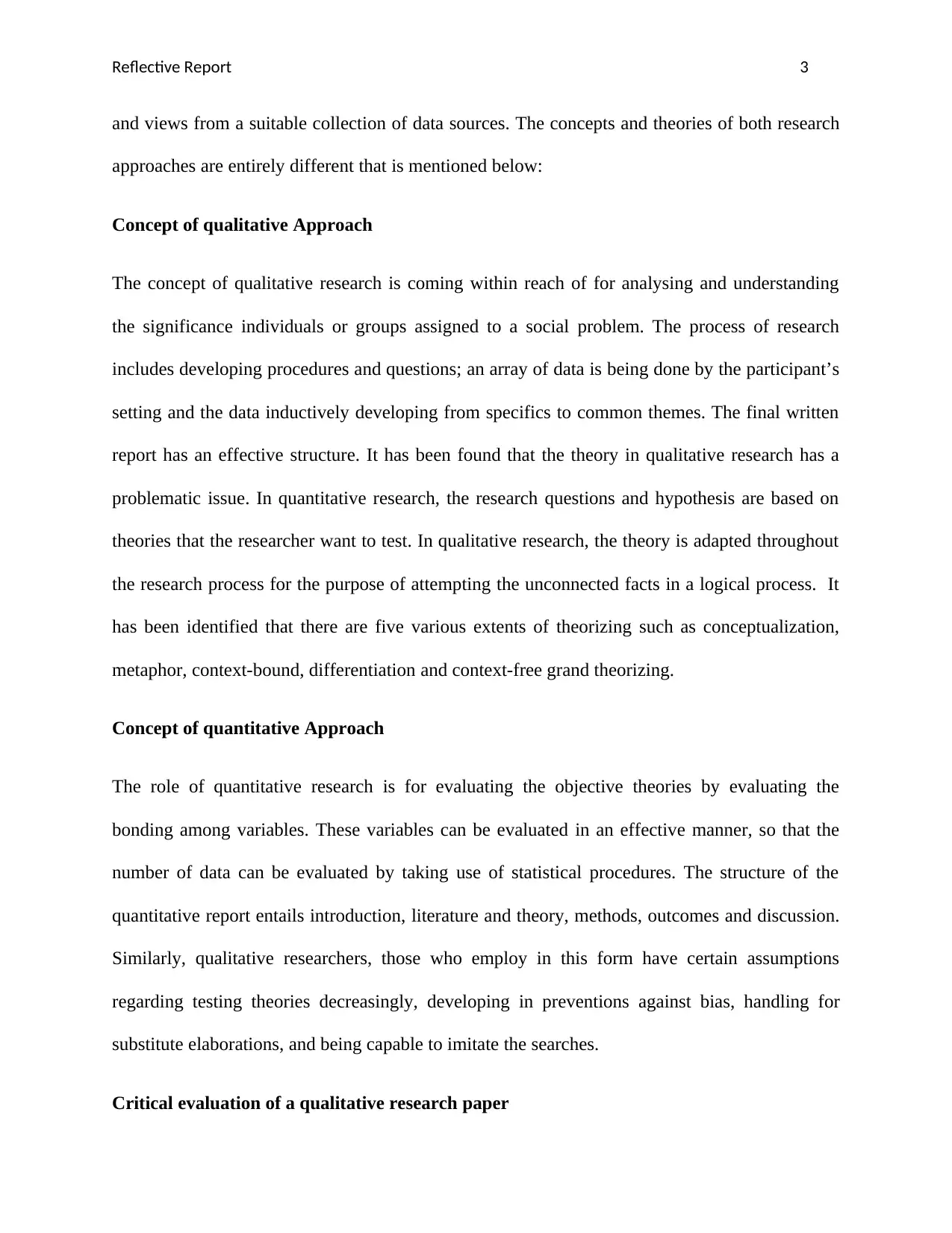
Reflective Report 3
and views from a suitable collection of data sources. The concepts and theories of both research
approaches are entirely different that is mentioned below:
Concept of qualitative Approach
The concept of qualitative research is coming within reach of for analysing and understanding
the significance individuals or groups assigned to a social problem. The process of research
includes developing procedures and questions; an array of data is being done by the participant’s
setting and the data inductively developing from specifics to common themes. The final written
report has an effective structure. It has been found that the theory in qualitative research has a
problematic issue. In quantitative research, the research questions and hypothesis are based on
theories that the researcher want to test. In qualitative research, the theory is adapted throughout
the research process for the purpose of attempting the unconnected facts in a logical process. It
has been identified that there are five various extents of theorizing such as conceptualization,
metaphor, context-bound, differentiation and context-free grand theorizing.
Concept of quantitative Approach
The role of quantitative research is for evaluating the objective theories by evaluating the
bonding among variables. These variables can be evaluated in an effective manner, so that the
number of data can be evaluated by taking use of statistical procedures. The structure of the
quantitative report entails introduction, literature and theory, methods, outcomes and discussion.
Similarly, qualitative researchers, those who employ in this form have certain assumptions
regarding testing theories decreasingly, developing in preventions against bias, handling for
substitute elaborations, and being capable to imitate the searches.
Critical evaluation of a qualitative research paper
and views from a suitable collection of data sources. The concepts and theories of both research
approaches are entirely different that is mentioned below:
Concept of qualitative Approach
The concept of qualitative research is coming within reach of for analysing and understanding
the significance individuals or groups assigned to a social problem. The process of research
includes developing procedures and questions; an array of data is being done by the participant’s
setting and the data inductively developing from specifics to common themes. The final written
report has an effective structure. It has been found that the theory in qualitative research has a
problematic issue. In quantitative research, the research questions and hypothesis are based on
theories that the researcher want to test. In qualitative research, the theory is adapted throughout
the research process for the purpose of attempting the unconnected facts in a logical process. It
has been identified that there are five various extents of theorizing such as conceptualization,
metaphor, context-bound, differentiation and context-free grand theorizing.
Concept of quantitative Approach
The role of quantitative research is for evaluating the objective theories by evaluating the
bonding among variables. These variables can be evaluated in an effective manner, so that the
number of data can be evaluated by taking use of statistical procedures. The structure of the
quantitative report entails introduction, literature and theory, methods, outcomes and discussion.
Similarly, qualitative researchers, those who employ in this form have certain assumptions
regarding testing theories decreasingly, developing in preventions against bias, handling for
substitute elaborations, and being capable to imitate the searches.
Critical evaluation of a qualitative research paper
⊘ This is a preview!⊘
Do you want full access?
Subscribe today to unlock all pages.

Trusted by 1+ million students worldwide
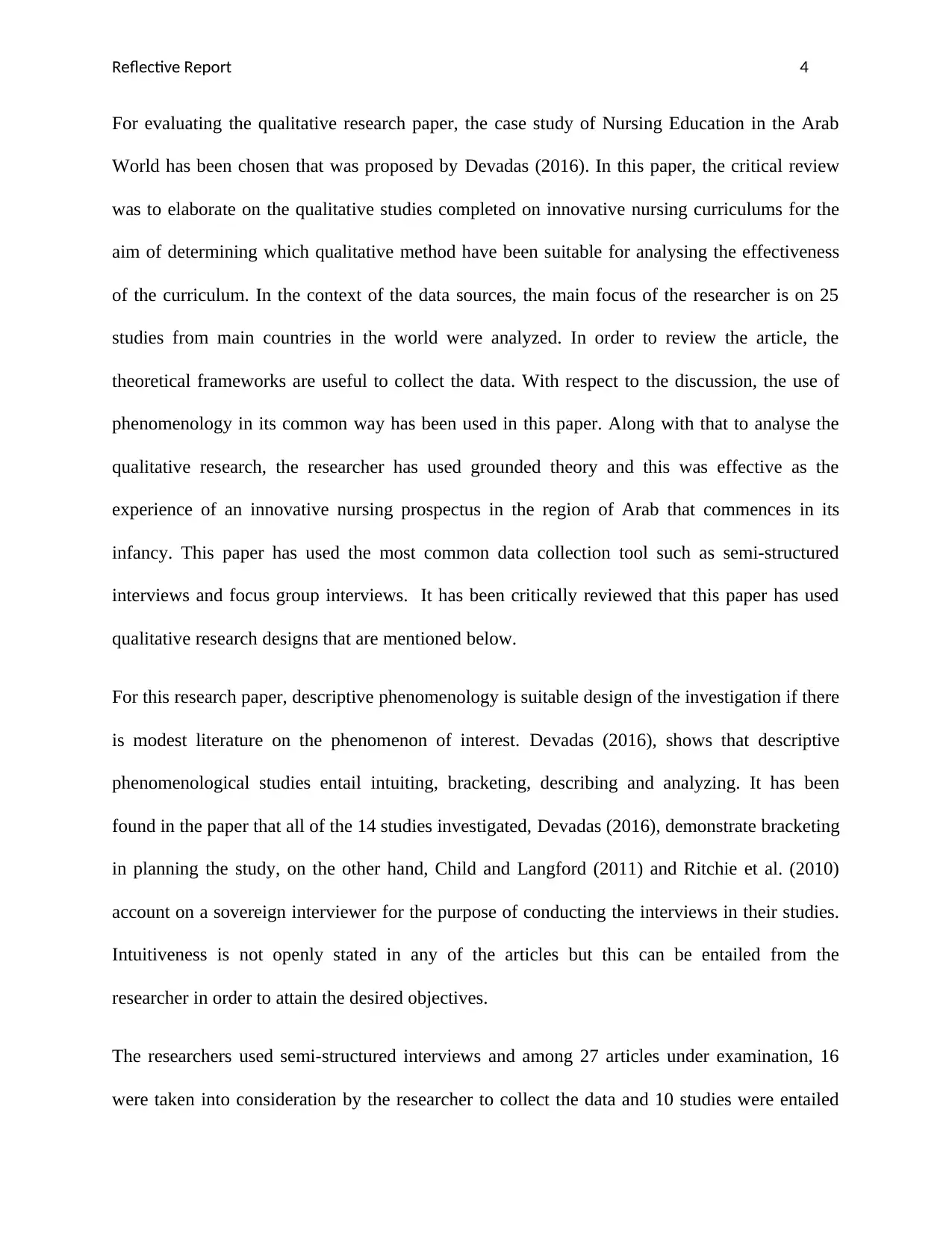
Reflective Report 4
For evaluating the qualitative research paper, the case study of Nursing Education in the Arab
World has been chosen that was proposed by Devadas (2016). In this paper, the critical review
was to elaborate on the qualitative studies completed on innovative nursing curriculums for the
aim of determining which qualitative method have been suitable for analysing the effectiveness
of the curriculum. In the context of the data sources, the main focus of the researcher is on 25
studies from main countries in the world were analyzed. In order to review the article, the
theoretical frameworks are useful to collect the data. With respect to the discussion, the use of
phenomenology in its common way has been used in this paper. Along with that to analyse the
qualitative research, the researcher has used grounded theory and this was effective as the
experience of an innovative nursing prospectus in the region of Arab that commences in its
infancy. This paper has used the most common data collection tool such as semi-structured
interviews and focus group interviews. It has been critically reviewed that this paper has used
qualitative research designs that are mentioned below.
For this research paper, descriptive phenomenology is suitable design of the investigation if there
is modest literature on the phenomenon of interest. Devadas (2016), shows that descriptive
phenomenological studies entail intuiting, bracketing, describing and analyzing. It has been
found in the paper that all of the 14 studies investigated, Devadas (2016), demonstrate bracketing
in planning the study, on the other hand, Child and Langford (2011) and Ritchie et al. (2010)
account on a sovereign interviewer for the purpose of conducting the interviews in their studies.
Intuitiveness is not openly stated in any of the articles but this can be entailed from the
researcher in order to attain the desired objectives.
The researchers used semi-structured interviews and among 27 articles under examination, 16
were taken into consideration by the researcher to collect the data and 10 studies were entailed
For evaluating the qualitative research paper, the case study of Nursing Education in the Arab
World has been chosen that was proposed by Devadas (2016). In this paper, the critical review
was to elaborate on the qualitative studies completed on innovative nursing curriculums for the
aim of determining which qualitative method have been suitable for analysing the effectiveness
of the curriculum. In the context of the data sources, the main focus of the researcher is on 25
studies from main countries in the world were analyzed. In order to review the article, the
theoretical frameworks are useful to collect the data. With respect to the discussion, the use of
phenomenology in its common way has been used in this paper. Along with that to analyse the
qualitative research, the researcher has used grounded theory and this was effective as the
experience of an innovative nursing prospectus in the region of Arab that commences in its
infancy. This paper has used the most common data collection tool such as semi-structured
interviews and focus group interviews. It has been critically reviewed that this paper has used
qualitative research designs that are mentioned below.
For this research paper, descriptive phenomenology is suitable design of the investigation if there
is modest literature on the phenomenon of interest. Devadas (2016), shows that descriptive
phenomenological studies entail intuiting, bracketing, describing and analyzing. It has been
found in the paper that all of the 14 studies investigated, Devadas (2016), demonstrate bracketing
in planning the study, on the other hand, Child and Langford (2011) and Ritchie et al. (2010)
account on a sovereign interviewer for the purpose of conducting the interviews in their studies.
Intuitiveness is not openly stated in any of the articles but this can be entailed from the
researcher in order to attain the desired objectives.
The researchers used semi-structured interviews and among 27 articles under examination, 16
were taken into consideration by the researcher to collect the data and 10 studies were entailed
Paraphrase This Document
Need a fresh take? Get an instant paraphrase of this document with our AI Paraphraser
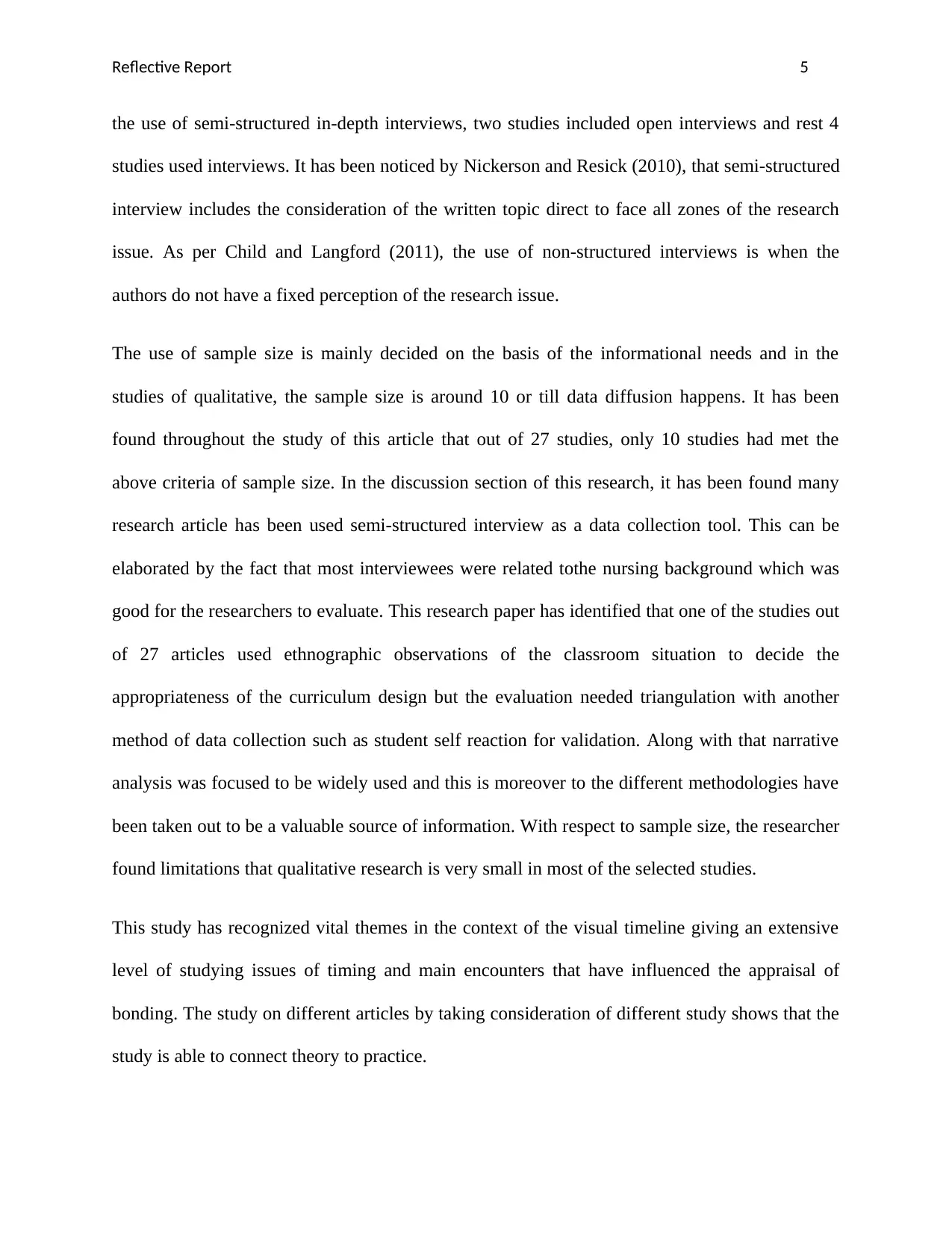
Reflective Report 5
the use of semi-structured in-depth interviews, two studies included open interviews and rest 4
studies used interviews. It has been noticed by Nickerson and Resick (2010), that semi-structured
interview includes the consideration of the written topic direct to face all zones of the research
issue. As per Child and Langford (2011), the use of non-structured interviews is when the
authors do not have a fixed perception of the research issue.
The use of sample size is mainly decided on the basis of the informational needs and in the
studies of qualitative, the sample size is around 10 or till data diffusion happens. It has been
found throughout the study of this article that out of 27 studies, only 10 studies had met the
above criteria of sample size. In the discussion section of this research, it has been found many
research article has been used semi-structured interview as a data collection tool. This can be
elaborated by the fact that most interviewees were related tothe nursing background which was
good for the researchers to evaluate. This research paper has identified that one of the studies out
of 27 articles used ethnographic observations of the classroom situation to decide the
appropriateness of the curriculum design but the evaluation needed triangulation with another
method of data collection such as student self reaction for validation. Along with that narrative
analysis was focused to be widely used and this is moreover to the different methodologies have
been taken out to be a valuable source of information. With respect to sample size, the researcher
found limitations that qualitative research is very small in most of the selected studies.
This study has recognized vital themes in the context of the visual timeline giving an extensive
level of studying issues of timing and main encounters that have influenced the appraisal of
bonding. The study on different articles by taking consideration of different study shows that the
study is able to connect theory to practice.
the use of semi-structured in-depth interviews, two studies included open interviews and rest 4
studies used interviews. It has been noticed by Nickerson and Resick (2010), that semi-structured
interview includes the consideration of the written topic direct to face all zones of the research
issue. As per Child and Langford (2011), the use of non-structured interviews is when the
authors do not have a fixed perception of the research issue.
The use of sample size is mainly decided on the basis of the informational needs and in the
studies of qualitative, the sample size is around 10 or till data diffusion happens. It has been
found throughout the study of this article that out of 27 studies, only 10 studies had met the
above criteria of sample size. In the discussion section of this research, it has been found many
research article has been used semi-structured interview as a data collection tool. This can be
elaborated by the fact that most interviewees were related tothe nursing background which was
good for the researchers to evaluate. This research paper has identified that one of the studies out
of 27 articles used ethnographic observations of the classroom situation to decide the
appropriateness of the curriculum design but the evaluation needed triangulation with another
method of data collection such as student self reaction for validation. Along with that narrative
analysis was focused to be widely used and this is moreover to the different methodologies have
been taken out to be a valuable source of information. With respect to sample size, the researcher
found limitations that qualitative research is very small in most of the selected studies.
This study has recognized vital themes in the context of the visual timeline giving an extensive
level of studying issues of timing and main encounters that have influenced the appraisal of
bonding. The study on different articles by taking consideration of different study shows that the
study is able to connect theory to practice.
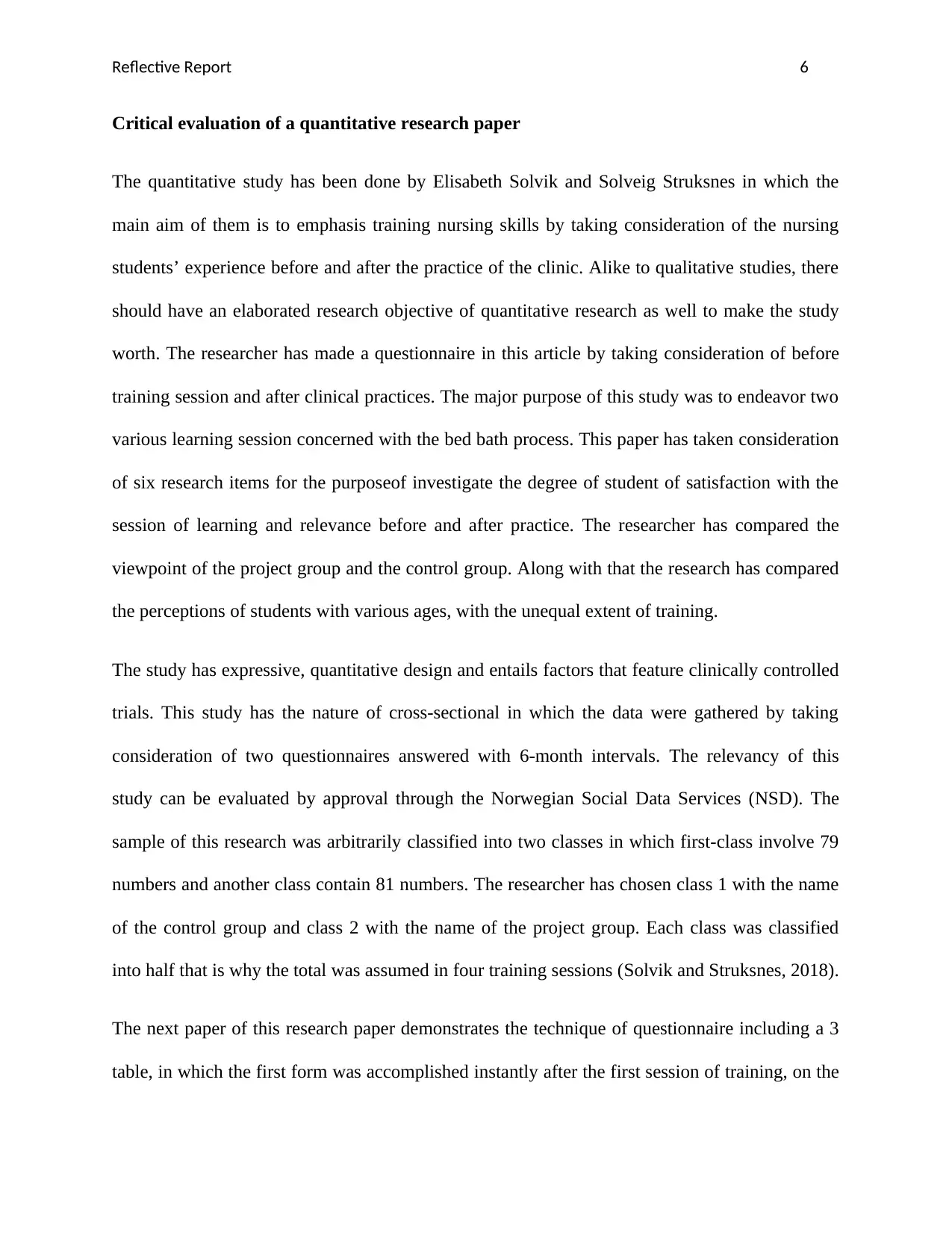
Reflective Report 6
Critical evaluation of a quantitative research paper
The quantitative study has been done by Elisabeth Solvik and Solveig Struksnes in which the
main aim of them is to emphasis training nursing skills by taking consideration of the nursing
students’ experience before and after the practice of the clinic. Alike to qualitative studies, there
should have an elaborated research objective of quantitative research as well to make the study
worth. The researcher has made a questionnaire in this article by taking consideration of before
training session and after clinical practices. The major purpose of this study was to endeavor two
various learning session concerned with the bed bath process. This paper has taken consideration
of six research items for the purposeof investigate the degree of student of satisfaction with the
session of learning and relevance before and after practice. The researcher has compared the
viewpoint of the project group and the control group. Along with that the research has compared
the perceptions of students with various ages, with the unequal extent of training.
The study has expressive, quantitative design and entails factors that feature clinically controlled
trials. This study has the nature of cross-sectional in which the data were gathered by taking
consideration of two questionnaires answered with 6-month intervals. The relevancy of this
study can be evaluated by approval through the Norwegian Social Data Services (NSD). The
sample of this research was arbitrarily classified into two classes in which first-class involve 79
numbers and another class contain 81 numbers. The researcher has chosen class 1 with the name
of the control group and class 2 with the name of the project group. Each class was classified
into half that is why the total was assumed in four training sessions (Solvik and Struksnes, 2018).
The next paper of this research paper demonstrates the technique of questionnaire including a 3
table, in which the first form was accomplished instantly after the first session of training, on the
Critical evaluation of a quantitative research paper
The quantitative study has been done by Elisabeth Solvik and Solveig Struksnes in which the
main aim of them is to emphasis training nursing skills by taking consideration of the nursing
students’ experience before and after the practice of the clinic. Alike to qualitative studies, there
should have an elaborated research objective of quantitative research as well to make the study
worth. The researcher has made a questionnaire in this article by taking consideration of before
training session and after clinical practices. The major purpose of this study was to endeavor two
various learning session concerned with the bed bath process. This paper has taken consideration
of six research items for the purposeof investigate the degree of student of satisfaction with the
session of learning and relevance before and after practice. The researcher has compared the
viewpoint of the project group and the control group. Along with that the research has compared
the perceptions of students with various ages, with the unequal extent of training.
The study has expressive, quantitative design and entails factors that feature clinically controlled
trials. This study has the nature of cross-sectional in which the data were gathered by taking
consideration of two questionnaires answered with 6-month intervals. The relevancy of this
study can be evaluated by approval through the Norwegian Social Data Services (NSD). The
sample of this research was arbitrarily classified into two classes in which first-class involve 79
numbers and another class contain 81 numbers. The researcher has chosen class 1 with the name
of the control group and class 2 with the name of the project group. Each class was classified
into half that is why the total was assumed in four training sessions (Solvik and Struksnes, 2018).
The next paper of this research paper demonstrates the technique of questionnaire including a 3
table, in which the first form was accomplished instantly after the first session of training, on the
⊘ This is a preview!⊘
Do you want full access?
Subscribe today to unlock all pages.

Trusted by 1+ million students worldwide
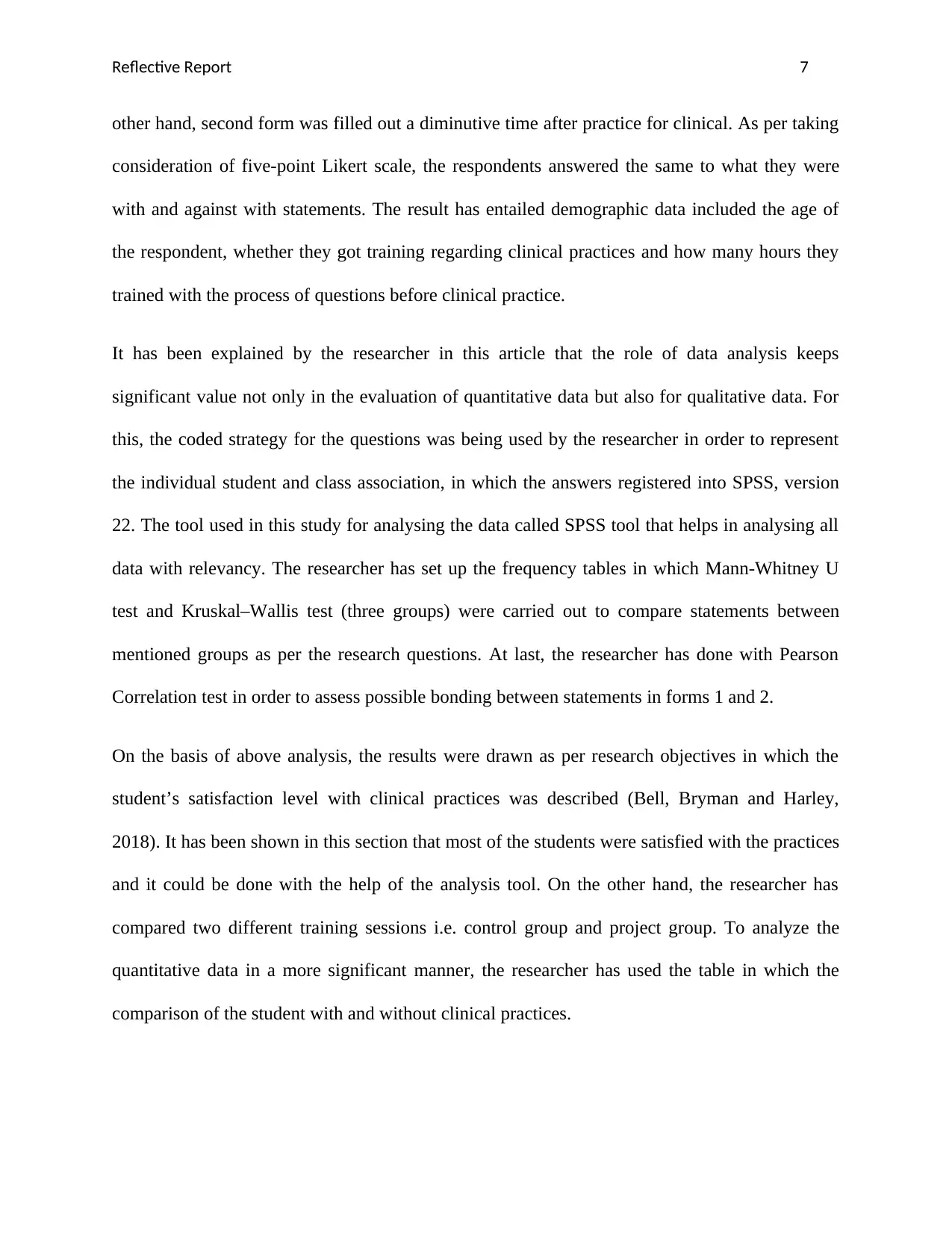
Reflective Report 7
other hand, second form was filled out a diminutive time after practice for clinical. As per taking
consideration of five-point Likert scale, the respondents answered the same to what they were
with and against with statements. The result has entailed demographic data included the age of
the respondent, whether they got training regarding clinical practices and how many hours they
trained with the process of questions before clinical practice.
It has been explained by the researcher in this article that the role of data analysis keeps
significant value not only in the evaluation of quantitative data but also for qualitative data. For
this, the coded strategy for the questions was being used by the researcher in order to represent
the individual student and class association, in which the answers registered into SPSS, version
22. The tool used in this study for analysing the data called SPSS tool that helps in analysing all
data with relevancy. The researcher has set up the frequency tables in which Mann-Whitney U
test and Kruskal–Wallis test (three groups) were carried out to compare statements between
mentioned groups as per the research questions. At last, the researcher has done with Pearson
Correlation test in order to assess possible bonding between statements in forms 1 and 2.
On the basis of above analysis, the results were drawn as per research objectives in which the
student’s satisfaction level with clinical practices was described (Bell, Bryman and Harley,
2018). It has been shown in this section that most of the students were satisfied with the practices
and it could be done with the help of the analysis tool. On the other hand, the researcher has
compared two different training sessions i.e. control group and project group. To analyze the
quantitative data in a more significant manner, the researcher has used the table in which the
comparison of the student with and without clinical practices.
other hand, second form was filled out a diminutive time after practice for clinical. As per taking
consideration of five-point Likert scale, the respondents answered the same to what they were
with and against with statements. The result has entailed demographic data included the age of
the respondent, whether they got training regarding clinical practices and how many hours they
trained with the process of questions before clinical practice.
It has been explained by the researcher in this article that the role of data analysis keeps
significant value not only in the evaluation of quantitative data but also for qualitative data. For
this, the coded strategy for the questions was being used by the researcher in order to represent
the individual student and class association, in which the answers registered into SPSS, version
22. The tool used in this study for analysing the data called SPSS tool that helps in analysing all
data with relevancy. The researcher has set up the frequency tables in which Mann-Whitney U
test and Kruskal–Wallis test (three groups) were carried out to compare statements between
mentioned groups as per the research questions. At last, the researcher has done with Pearson
Correlation test in order to assess possible bonding between statements in forms 1 and 2.
On the basis of above analysis, the results were drawn as per research objectives in which the
student’s satisfaction level with clinical practices was described (Bell, Bryman and Harley,
2018). It has been shown in this section that most of the students were satisfied with the practices
and it could be done with the help of the analysis tool. On the other hand, the researcher has
compared two different training sessions i.e. control group and project group. To analyze the
quantitative data in a more significant manner, the researcher has used the table in which the
comparison of the student with and without clinical practices.
Paraphrase This Document
Need a fresh take? Get an instant paraphrase of this document with our AI Paraphraser
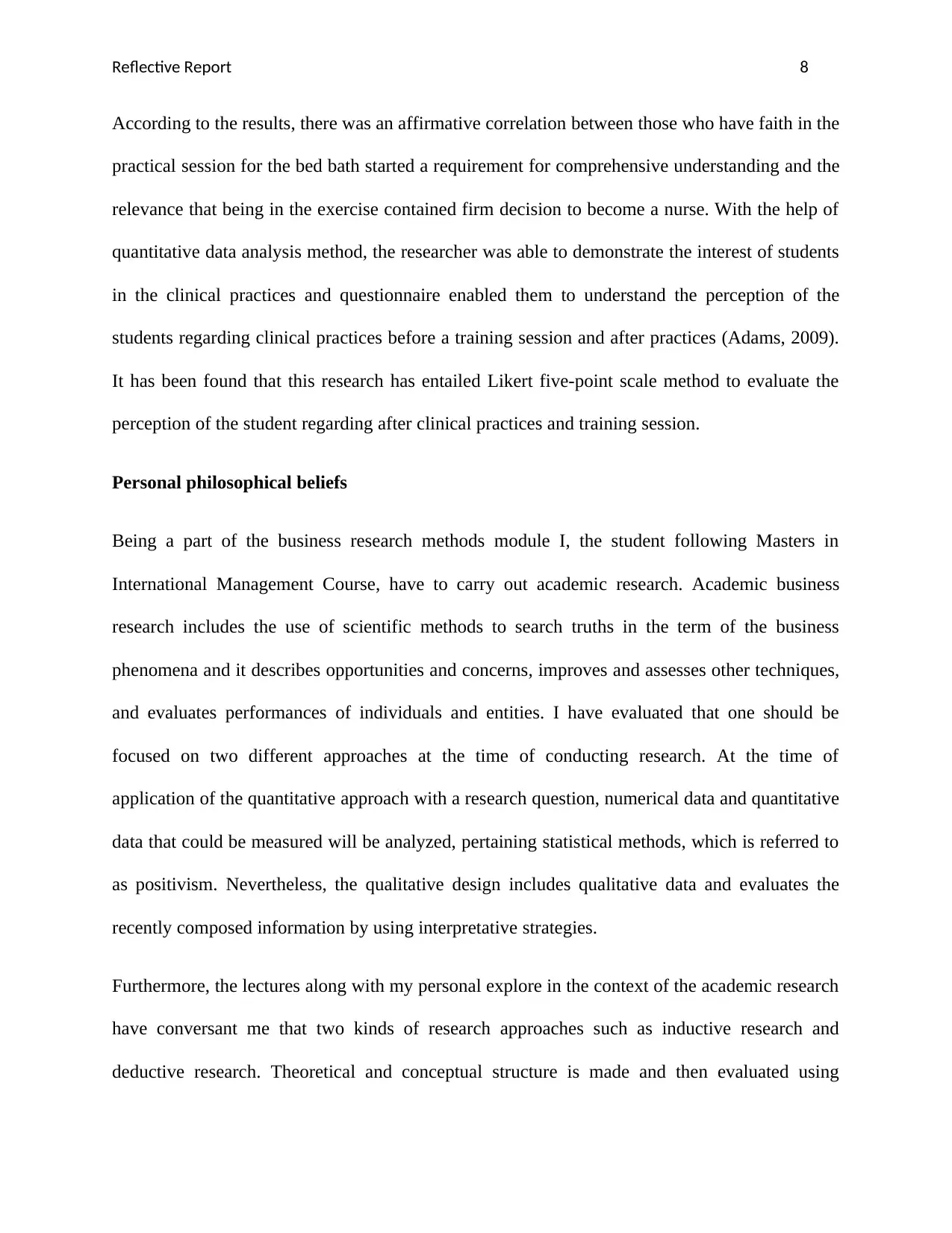
Reflective Report 8
According to the results, there was an affirmative correlation between those who have faith in the
practical session for the bed bath started a requirement for comprehensive understanding and the
relevance that being in the exercise contained firm decision to become a nurse. With the help of
quantitative data analysis method, the researcher was able to demonstrate the interest of students
in the clinical practices and questionnaire enabled them to understand the perception of the
students regarding clinical practices before a training session and after practices (Adams, 2009).
It has been found that this research has entailed Likert five-point scale method to evaluate the
perception of the student regarding after clinical practices and training session.
Personal philosophical beliefs
Being a part of the business research methods module I, the student following Masters in
International Management Course, have to carry out academic research. Academic business
research includes the use of scientific methods to search truths in the term of the business
phenomena and it describes opportunities and concerns, improves and assesses other techniques,
and evaluates performances of individuals and entities. I have evaluated that one should be
focused on two different approaches at the time of conducting research. At the time of
application of the quantitative approach with a research question, numerical data and quantitative
data that could be measured will be analyzed, pertaining statistical methods, which is referred to
as positivism. Nevertheless, the qualitative design includes qualitative data and evaluates the
recently composed information by using interpretative strategies.
Furthermore, the lectures along with my personal explore in the context of the academic research
have conversant me that two kinds of research approaches such as inductive research and
deductive research. Theoretical and conceptual structure is made and then evaluated using
According to the results, there was an affirmative correlation between those who have faith in the
practical session for the bed bath started a requirement for comprehensive understanding and the
relevance that being in the exercise contained firm decision to become a nurse. With the help of
quantitative data analysis method, the researcher was able to demonstrate the interest of students
in the clinical practices and questionnaire enabled them to understand the perception of the
students regarding clinical practices before a training session and after practices (Adams, 2009).
It has been found that this research has entailed Likert five-point scale method to evaluate the
perception of the student regarding after clinical practices and training session.
Personal philosophical beliefs
Being a part of the business research methods module I, the student following Masters in
International Management Course, have to carry out academic research. Academic business
research includes the use of scientific methods to search truths in the term of the business
phenomena and it describes opportunities and concerns, improves and assesses other techniques,
and evaluates performances of individuals and entities. I have evaluated that one should be
focused on two different approaches at the time of conducting research. At the time of
application of the quantitative approach with a research question, numerical data and quantitative
data that could be measured will be analyzed, pertaining statistical methods, which is referred to
as positivism. Nevertheless, the qualitative design includes qualitative data and evaluates the
recently composed information by using interpretative strategies.
Furthermore, the lectures along with my personal explore in the context of the academic research
have conversant me that two kinds of research approaches such as inductive research and
deductive research. Theoretical and conceptual structure is made and then evaluated using
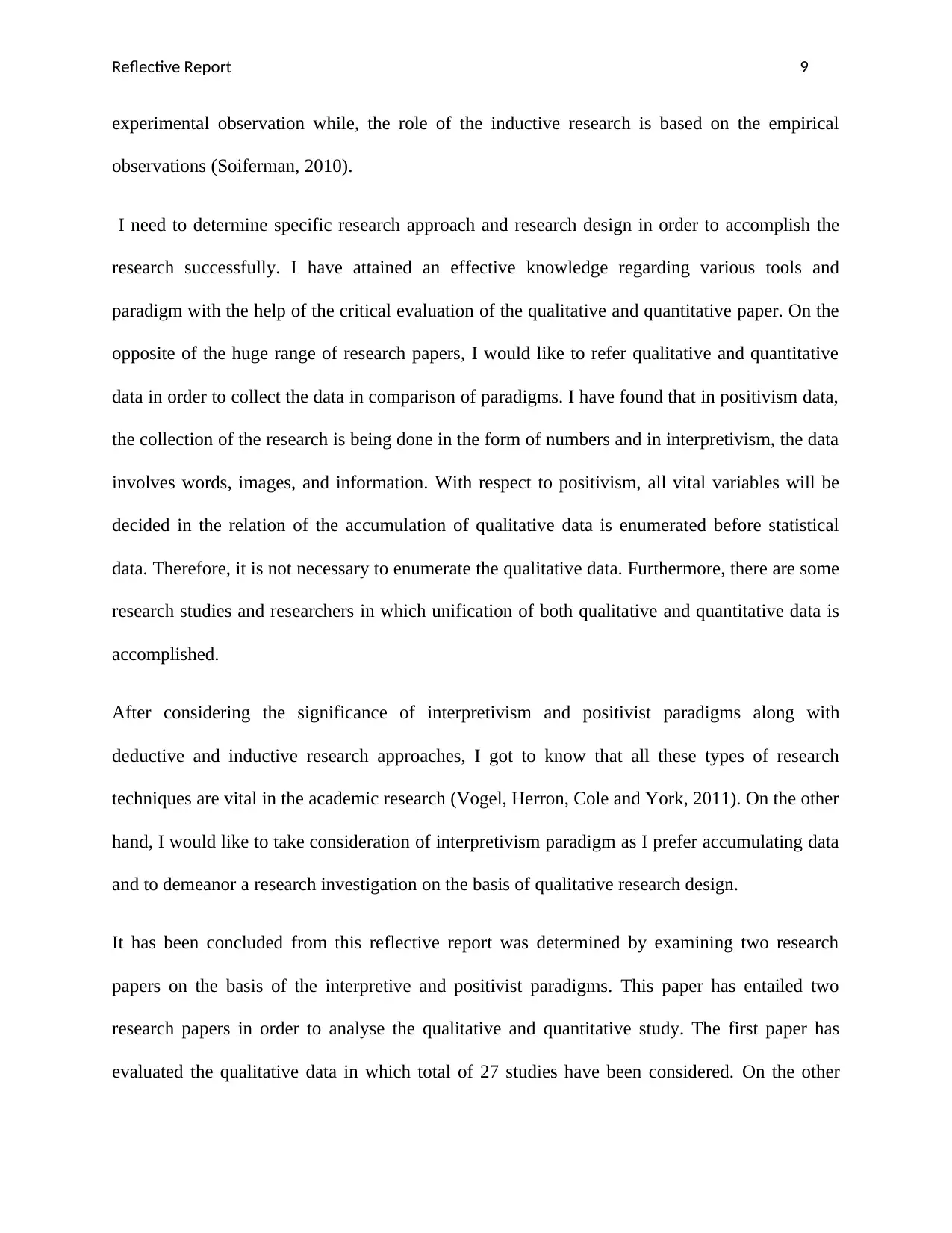
Reflective Report 9
experimental observation while, the role of the inductive research is based on the empirical
observations (Soiferman, 2010).
I need to determine specific research approach and research design in order to accomplish the
research successfully. I have attained an effective knowledge regarding various tools and
paradigm with the help of the critical evaluation of the qualitative and quantitative paper. On the
opposite of the huge range of research papers, I would like to refer qualitative and quantitative
data in order to collect the data in comparison of paradigms. I have found that in positivism data,
the collection of the research is being done in the form of numbers and in interpretivism, the data
involves words, images, and information. With respect to positivism, all vital variables will be
decided in the relation of the accumulation of qualitative data is enumerated before statistical
data. Therefore, it is not necessary to enumerate the qualitative data. Furthermore, there are some
research studies and researchers in which unification of both qualitative and quantitative data is
accomplished.
After considering the significance of interpretivism and positivist paradigms along with
deductive and inductive research approaches, I got to know that all these types of research
techniques are vital in the academic research (Vogel, Herron, Cole and York, 2011). On the other
hand, I would like to take consideration of interpretivism paradigm as I prefer accumulating data
and to demeanor a research investigation on the basis of qualitative research design.
It has been concluded from this reflective report was determined by examining two research
papers on the basis of the interpretive and positivist paradigms. This paper has entailed two
research papers in order to analyse the qualitative and quantitative study. The first paper has
evaluated the qualitative data in which total of 27 studies have been considered. On the other
experimental observation while, the role of the inductive research is based on the empirical
observations (Soiferman, 2010).
I need to determine specific research approach and research design in order to accomplish the
research successfully. I have attained an effective knowledge regarding various tools and
paradigm with the help of the critical evaluation of the qualitative and quantitative paper. On the
opposite of the huge range of research papers, I would like to refer qualitative and quantitative
data in order to collect the data in comparison of paradigms. I have found that in positivism data,
the collection of the research is being done in the form of numbers and in interpretivism, the data
involves words, images, and information. With respect to positivism, all vital variables will be
decided in the relation of the accumulation of qualitative data is enumerated before statistical
data. Therefore, it is not necessary to enumerate the qualitative data. Furthermore, there are some
research studies and researchers in which unification of both qualitative and quantitative data is
accomplished.
After considering the significance of interpretivism and positivist paradigms along with
deductive and inductive research approaches, I got to know that all these types of research
techniques are vital in the academic research (Vogel, Herron, Cole and York, 2011). On the other
hand, I would like to take consideration of interpretivism paradigm as I prefer accumulating data
and to demeanor a research investigation on the basis of qualitative research design.
It has been concluded from this reflective report was determined by examining two research
papers on the basis of the interpretive and positivist paradigms. This paper has entailed two
research papers in order to analyse the qualitative and quantitative study. The first paper has
evaluated the qualitative data in which total of 27 studies have been considered. On the other
⊘ This is a preview!⊘
Do you want full access?
Subscribe today to unlock all pages.

Trusted by 1+ million students worldwide
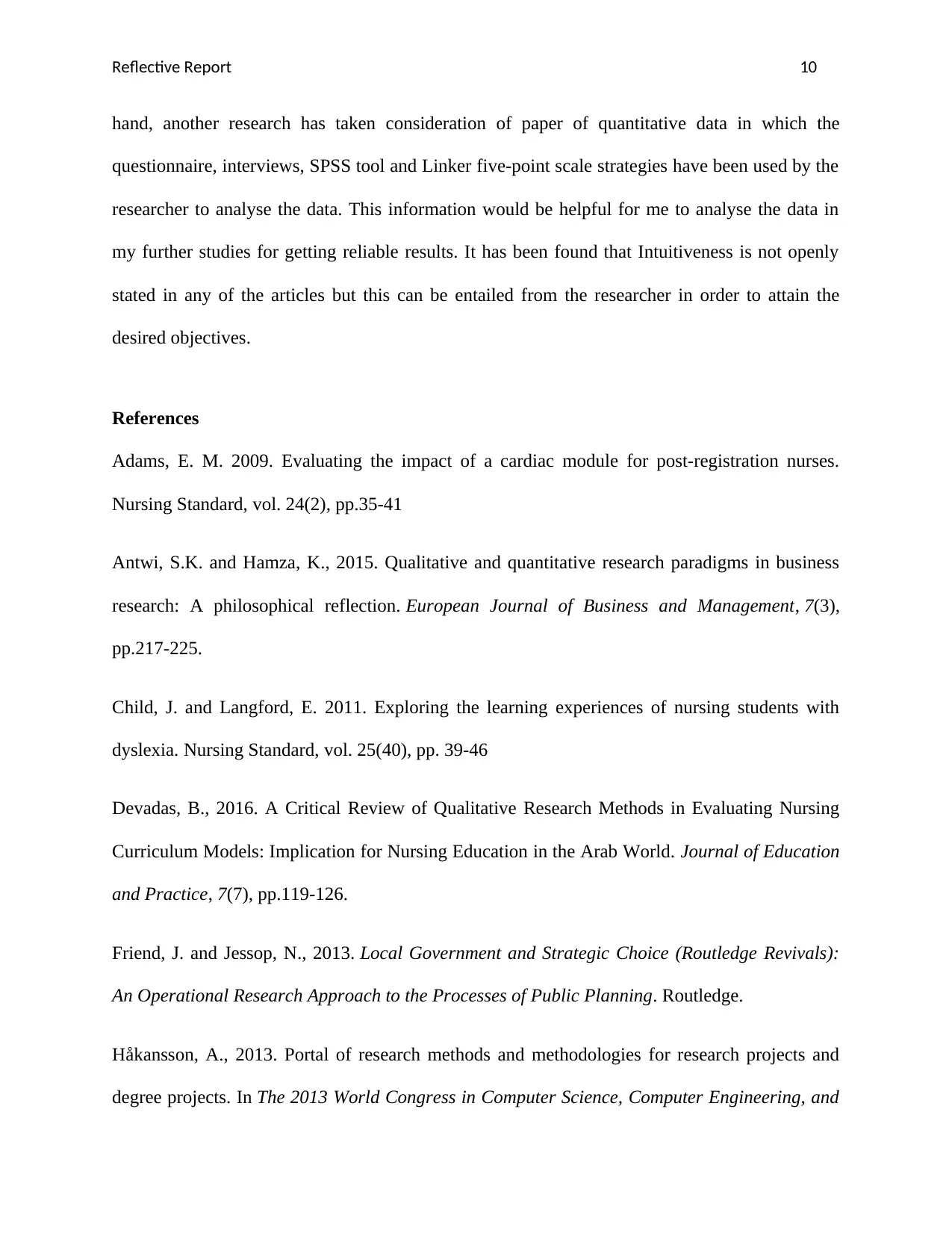
Reflective Report 10
hand, another research has taken consideration of paper of quantitative data in which the
questionnaire, interviews, SPSS tool and Linker five-point scale strategies have been used by the
researcher to analyse the data. This information would be helpful for me to analyse the data in
my further studies for getting reliable results. It has been found that Intuitiveness is not openly
stated in any of the articles but this can be entailed from the researcher in order to attain the
desired objectives.
References
Adams, E. M. 2009. Evaluating the impact of a cardiac module for post-registration nurses.
Nursing Standard, vol. 24(2), pp.35-41
Antwi, S.K. and Hamza, K., 2015. Qualitative and quantitative research paradigms in business
research: A philosophical reflection. European Journal of Business and Management, 7(3),
pp.217-225.
Child, J. and Langford, E. 2011. Exploring the learning experiences of nursing students with
dyslexia. Nursing Standard, vol. 25(40), pp. 39-46
Devadas, B., 2016. A Critical Review of Qualitative Research Methods in Evaluating Nursing
Curriculum Models: Implication for Nursing Education in the Arab World. Journal of Education
and Practice, 7(7), pp.119-126.
Friend, J. and Jessop, N., 2013. Local Government and Strategic Choice (Routledge Revivals):
An Operational Research Approach to the Processes of Public Planning. Routledge.
Håkansson, A., 2013. Portal of research methods and methodologies for research projects and
degree projects. In The 2013 World Congress in Computer Science, Computer Engineering, and
hand, another research has taken consideration of paper of quantitative data in which the
questionnaire, interviews, SPSS tool and Linker five-point scale strategies have been used by the
researcher to analyse the data. This information would be helpful for me to analyse the data in
my further studies for getting reliable results. It has been found that Intuitiveness is not openly
stated in any of the articles but this can be entailed from the researcher in order to attain the
desired objectives.
References
Adams, E. M. 2009. Evaluating the impact of a cardiac module for post-registration nurses.
Nursing Standard, vol. 24(2), pp.35-41
Antwi, S.K. and Hamza, K., 2015. Qualitative and quantitative research paradigms in business
research: A philosophical reflection. European Journal of Business and Management, 7(3),
pp.217-225.
Child, J. and Langford, E. 2011. Exploring the learning experiences of nursing students with
dyslexia. Nursing Standard, vol. 25(40), pp. 39-46
Devadas, B., 2016. A Critical Review of Qualitative Research Methods in Evaluating Nursing
Curriculum Models: Implication for Nursing Education in the Arab World. Journal of Education
and Practice, 7(7), pp.119-126.
Friend, J. and Jessop, N., 2013. Local Government and Strategic Choice (Routledge Revivals):
An Operational Research Approach to the Processes of Public Planning. Routledge.
Håkansson, A., 2013. Portal of research methods and methodologies for research projects and
degree projects. In The 2013 World Congress in Computer Science, Computer Engineering, and
Paraphrase This Document
Need a fresh take? Get an instant paraphrase of this document with our AI Paraphraser
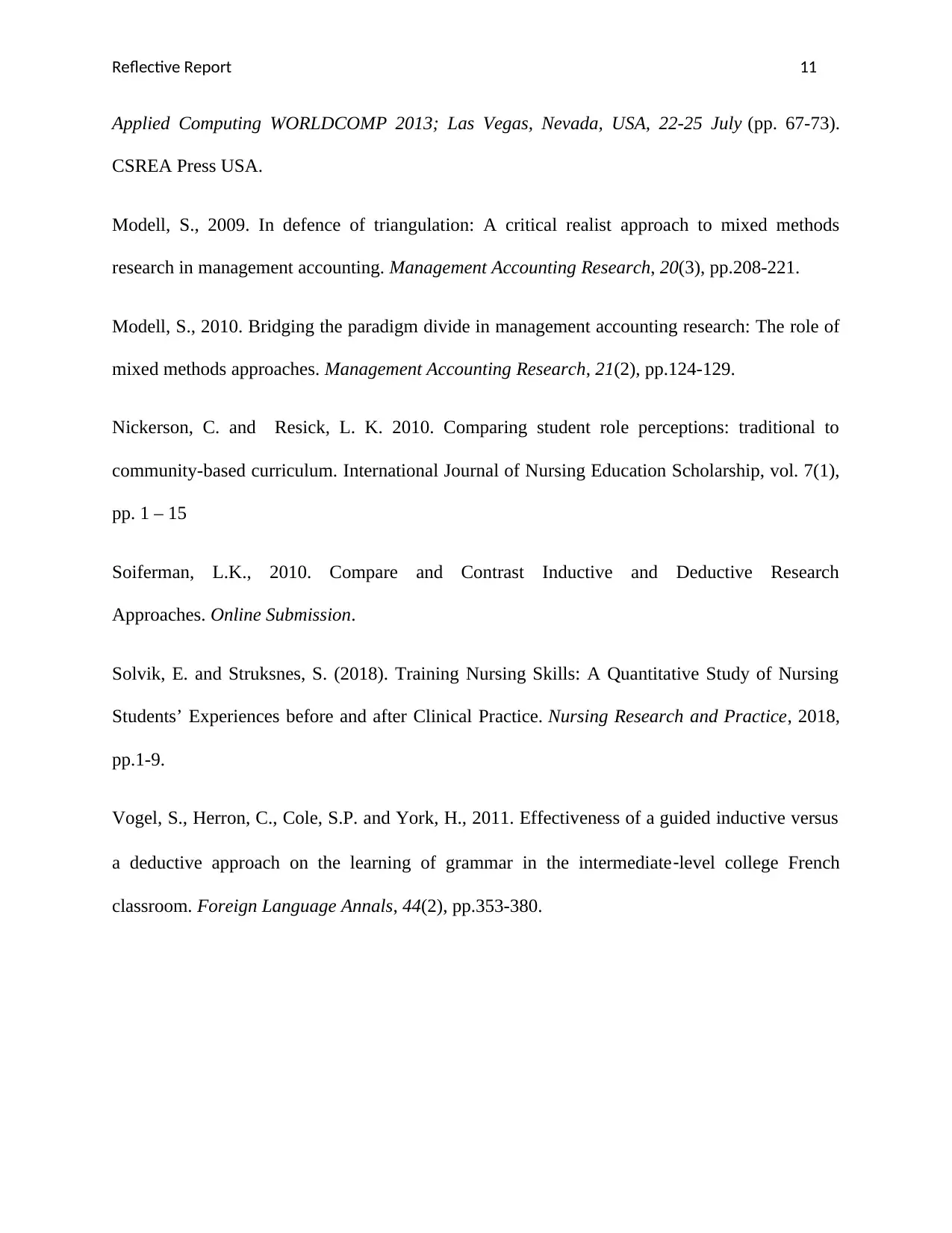
Reflective Report 11
Applied Computing WORLDCOMP 2013; Las Vegas, Nevada, USA, 22-25 July (pp. 67-73).
CSREA Press USA.
Modell, S., 2009. In defence of triangulation: A critical realist approach to mixed methods
research in management accounting. Management Accounting Research, 20(3), pp.208-221.
Modell, S., 2010. Bridging the paradigm divide in management accounting research: The role of
mixed methods approaches. Management Accounting Research, 21(2), pp.124-129.
Nickerson, C. and Resick, L. K. 2010. Comparing student role perceptions: traditional to
community-based curriculum. International Journal of Nursing Education Scholarship, vol. 7(1),
pp. 1 – 15
Soiferman, L.K., 2010. Compare and Contrast Inductive and Deductive Research
Approaches. Online Submission.
Solvik, E. and Struksnes, S. (2018). Training Nursing Skills: A Quantitative Study of Nursing
Students’ Experiences before and after Clinical Practice. Nursing Research and Practice, 2018,
pp.1-9.
Vogel, S., Herron, C., Cole, S.P. and York, H., 2011. Effectiveness of a guided inductive versus
a deductive approach on the learning of grammar in the intermediate‐level college French
classroom. Foreign Language Annals, 44(2), pp.353-380.
Applied Computing WORLDCOMP 2013; Las Vegas, Nevada, USA, 22-25 July (pp. 67-73).
CSREA Press USA.
Modell, S., 2009. In defence of triangulation: A critical realist approach to mixed methods
research in management accounting. Management Accounting Research, 20(3), pp.208-221.
Modell, S., 2010. Bridging the paradigm divide in management accounting research: The role of
mixed methods approaches. Management Accounting Research, 21(2), pp.124-129.
Nickerson, C. and Resick, L. K. 2010. Comparing student role perceptions: traditional to
community-based curriculum. International Journal of Nursing Education Scholarship, vol. 7(1),
pp. 1 – 15
Soiferman, L.K., 2010. Compare and Contrast Inductive and Deductive Research
Approaches. Online Submission.
Solvik, E. and Struksnes, S. (2018). Training Nursing Skills: A Quantitative Study of Nursing
Students’ Experiences before and after Clinical Practice. Nursing Research and Practice, 2018,
pp.1-9.
Vogel, S., Herron, C., Cole, S.P. and York, H., 2011. Effectiveness of a guided inductive versus
a deductive approach on the learning of grammar in the intermediate‐level college French
classroom. Foreign Language Annals, 44(2), pp.353-380.
1 out of 11
Related Documents
Your All-in-One AI-Powered Toolkit for Academic Success.
+13062052269
info@desklib.com
Available 24*7 on WhatsApp / Email
![[object Object]](/_next/static/media/star-bottom.7253800d.svg)
Unlock your academic potential
Copyright © 2020–2025 A2Z Services. All Rights Reserved. Developed and managed by ZUCOL.




